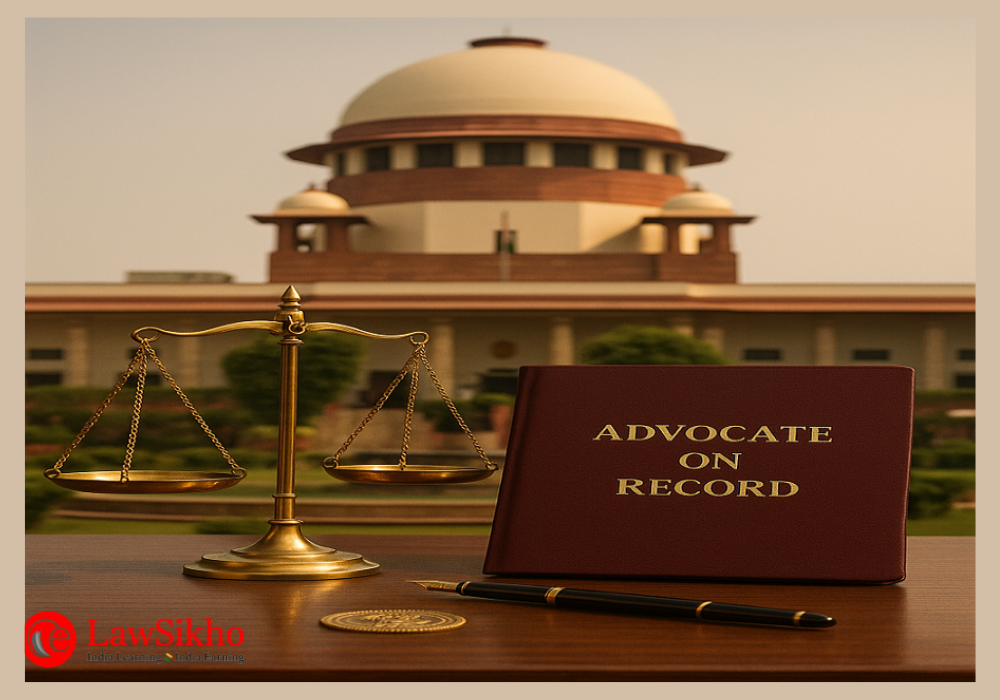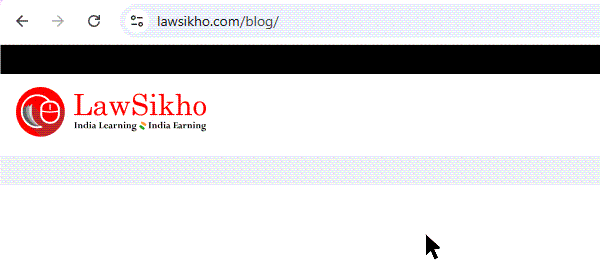Curious about the Advocate on Record meaning and its significance in relevance to the Supreme Court of India? This detailed guide explains the legal definition, exclusive Supreme Court rights, and step-by-step process of becoming an AOR in India. Learn how AORs differ from regular advocates and why this designation is one of the most prestigious qualifications in Indian law.
Table of Contents
Out of nearly 20 lakh practicing lawyers in India, only 3,789 hold a professional credential so exclusive that without it, you cannot independently file even a single case before the Supreme Court of India.
This elite designation is the Advocate on Record qualification, a credential that transforms regular advocates into Supreme Court practitioners overnight.
Imagine reaching a point in your legal career where you’ve mastered High Court litigation, built a respectable client base, and earned professional credibility, yet you still cannot step into India’s highest court and file a case on your own.
This is the reality every non AOR advocate faces, regardless of their experience or expertise.
The question becomes: when do you cross this bridge and what does it really mean to become an Advocate on Record?
What does it take to join the exclusive club of advocates who argue landmark constitutional matters, represent Fortune 500 companies in their biggest legal battles, and shape the law that governs 1.4 billion people?
The answer lies in understanding what Advocate on Record truly means, not just as a designation, but as a gateway to the pinnacle of Indian legal practice.
If you’ve ever wondered about the meaning of Advocate on Record and what separates these specialized legal professionals from regular advocates, you’re in the right place.
The Advocate on Record (AOR) designation represents one of the most prestigious and legally significant qualifications in Indian jurisprudence, granting exclusive rights to practice before the Supreme Court of India that no other advocate, regardless of their brilliance or experience, can claim without this credential.
This comprehensive guide demystifies everything you need to know about AOR: the constitutional framework that created this system, the rigorous qualification process that tests even seasoned lawyers, the exclusive practice rights that make this designation invaluable, and the practical realities of life as a Supreme Court practitioner.
Whether you’re a law student charting your career trajectory, a junior advocate wondering if Supreme Court practice aligns with your professional goals, or a mid-career lawyer evaluating when to pursue this qualification, understanding the complete meaning and implications of becoming an Advocate on Record is essential for making informed decisions about your legal career path.
By the end of this article, you’ll have clarity on what AOR truly means in both legal and practical terms, why this qualification matters for India’s judicial system, and whether pursuing AOR status is the right move for your unique career circumstances.
Who is an Advocate on Record?
Advocate on Record Meaning
An Advocate on Record is a specialized legal professional who holds the exclusive authority to file cases, submit petitions, and represent clients directly before the Supreme Court of India.
Unlike regular advocates who can practice in district courts and High Courts, AORs are the only lawyers entitled to act and plead for parties in India’s apex court.
This designation isn’t just a title; it’s a legally mandated requirement under Supreme Court Rules that ensures only trained, experienced advocates handle matters at the highest judicial level in the country.
Basic Legal Definition Under Supreme Court Rules
Order I Rule 2(1)(b) of the Supreme Court Rules 2013 states that an advocate on record is an advocate who is entitled under these rules to act as well as to plead for a party in the Court.
This means that no other advocate can file an appearance or act for a party in the Supreme Court unless they hold AOR status.
Even senior advocates or advocates from other courts must be instructed by an AOR to appear before the Supreme Court, making the AOR the essential intermediary between clients and India’s highest court.
What is The Significance of an Advocate on Record?

Filing and Appearance Rights in the Supreme Court
The significance of an Advocate on Record lies primarily in their exclusive filing and appearance rights before the Supreme Court.
Here’s what you need to understand about these privileges and why they matter for Supreme Court practice.
Only an AOR can file a Vakalatnama, the formal document appointing an advocate to represent a client in the Supreme Court.
This means that regardless of how experienced or skilled a lawyer might be in High Court or district court practice, they cannot independently handle Supreme Court matters without either becoming an AOR themselves or working through one.
This exclusive filing right makes AORs the gatekeepers of Supreme Court litigation in India.
The appearance rights are equally significant.
While non AOR advocates, including senior advocates and High Court practitioners, can argue cases before the Supreme Court, they can only do so when specifically instructed by an AOR. This means every Supreme Court matter must have an AOR on record who takes responsibility for all procedural compliance, document filing, and court communications.
The AOR’s name appears on the cause list, receives all notices from the court, and bears ultimate responsibility for the case’s procedural aspects.This system serves a crucial quality control function.
The practical significance extends beyond just filing rights. As an AOR, you gain the authority to directly represent clients in the highest court without needing another advocate’s permission or instruction.
This independence translates to better client relationships, higher professional credibility, and the ability to control your Supreme Court practice completely.
Clients seeking Supreme Court representation must engage an AOR, which means this qualification opens up an entirely new client base and practice area that’s simply inaccessible to non AOR advocates.
Advocate on Record Meaning: Legal Framework
Article 145(1) of Constitution
Article 145(1) of the Indian Constitution provides the foundational authority for the Advocate on Record system by granting the Supreme Court the power to make rules regulating its own practice and procedure.
This constitutional provision specifically states that the Supreme Court may, with the approval of the President, make rules determining the persons who shall be entitled to practice before the court.
It’s under this constitutional mandate that the Supreme Court has established the AOR system, ensuring that the court’s rule making power includes defining who can appear and act for parties in Supreme Court proceedings.
Order IV of Supreme Court Rules 2013
Order IV of the Supreme Court Rules 2013 is the comprehensive legal chapter that operationalizes the constitutional power granted under Article 145 and governs everything about the AOR system. This Order lays down the eligibility criteria, defines the scope of authority once you become an AOR, specifies professional duties and responsibilities, and outlines consequences of misconduct.
Advocate on Record Meaning: Eligibility and Qualification Process
Five Stages to Becoming an Advocate on Record
Becoming an Advocate on Record requires successfully navigating five distinct stages that typically span 5 to 6 years from Bar Council enrollment to active Supreme Court practice.
This structured pathway ensures that only advocates with adequate experience, specialized training, and demonstrated knowledge of Supreme Court procedures receive AOR status.
Let me walk you through each stage and what you need to know about successfully completing this journey.

Stage 1: Law Degree and Bar Council Enrollment
Your journey to becoming an AOR begins with obtaining a recognized law degree, either a three year LLB after graduation or an integrated five year BA LLB/BBA LLB/BSc LLB program.
Once you complete your law degree, you must enroll with any State Bar Council in India as a practicing advocate. This enrollment is mandatory because the AOR eligibility requirements specifically state that you must be enrolled as an advocate with a State Bar Council before you can even count practice years toward AOR qualification.
Here’s what matters for this stage: the quality of your law school or your academic performance doesn’t directly impact AOR eligibility, what matters is valid Bar Council enrollment and the commencement of your legal practice.
Whether you studied at a National Law University or a private law college, whether you ranked first or just passed, you start at the same point once you’re enrolled with the Bar Council. The real differentiation begins in how you build your practice experience over the next four years.
Stage 2: Four Years of Legal Practice Experience
After Bar Council enrollment, you need to accumulate four years of continuous practice as an advocate before you’re eligible to apply for AOR training.
This four year period is crucial. It’s not just about waiting for time to pass but about building the foundational legal skills, courtroom experience, and understanding of litigation procedures that will prepare you for Supreme Court practice.
What counts as practice experience?
Generally, this includes appearing in courts, drafting legal documents, providing legal consultancy, and other professional legal work. If you’re working in a law firm, practicing independently, or working with a senior advocate, all of this counts toward your four year requirement.
Stage 3: One Year Training Under Senior AOR
Once you complete four years of practice, you must undergo one year of mandatory training under a senior Advocate on Record who has at least ten years of standing as an AOR.
This training period is perhaps the most critical stage because it’s where you learn the specific procedures, practices, and unwritten rules of Supreme Court work that you simply cannot learn from books or in other courts.
Finding the right training AOR can significantly impact your learning experience and your future Supreme Court practice success.
During this training year, you’ll work closely with your senior AOR on actual Supreme Court matters, drafting petitions, preparing case files, understanding Registry requirements, learning how to file applications, and observing courtroom proceedings.
The training covers practical aspects like how to prepare a proper Supreme Court petition, what documents the Registry requires, how to cite cases in Supreme Court format, and the specific procedural rules that govern Supreme Court practice.
Your training AOR must provide you with a training completion certificate at the end of the year, which you’ll need when applying for the AOR examination.
Finding a senior AOR willing to take you on for training can be challenging, especially if you’re based outside Delhi.
Here’s a practical tip: start networking with AORs well before you complete your four years of practice.
Attend Supreme Court Bar Association events if possible and reach out to AORs who practice in your area of specialization, and demonstrate your seriousness about Supreme Court practice.
Many AORs are willing to train motivated advocates, especially if you can offer valuable research and drafting assistance in exchange for training.
Some training arrangements are pro bono, while others involve you working as a paid associate, both are acceptable as long as you receive proper training in Supreme Court procedures.
Stage 4: AOR Exam Conducted by the Supreme Court
After completing your one year training, you’re eligible to appear for the AOR examination, which the Supreme Court conducts annually, typically between May and June.
This examination is notoriously difficult, with pass rates historically around 20-30%, meaning approximately 70-80% of candidates fail.
The exam consists of four papers covering different aspects of Supreme Court practice: Practice and Procedure, Drafting, Professional Ethics, and Leadings cases of the Supreme Court.You can refer to my article on the AOR Exam Syllabus to check out the detailed syllabus.
Each paper is three hours long (except the drafting paper where you get 30 mins extra) and tests your practical understanding of how Supreme Court practice works rather than theoretical legal knowledge.
The Practice and Procedure paper, for instance, asks you how you would handle specific procedural situations in the Supreme Court, what documents you’d file, what rules apply, what timeline you’d follow.
The Drafting paper requires you to actually draft Supreme Court petitions, applications, or other documents under examination conditions.
Professional Ethics and Advocacy paper tests your ethical judgment and understanding of professional conduct standards, competencies that distinguish mere legal technicians from true professionals.
Leading Cases paper tests your familiarity with landmark Supreme Court jurisprudence that forms the foundation of Indian constitutional and legal framework.
You need to score at least 50% in each individual paper and 60% in aggregate to pass the examination.
The examination is evaluated by senior advocates and experienced AORs, who look for clarity, precision, and practical understanding in your answers.
They can immediately spot if you’re writing theoretical law school answers versus practical Supreme Court procedure responses.
This is why the one year training is so crucial, it gives you the practical exposure that directly translates to exam success.
If you’re preparing for the AOR exam while maintaining your practice, I recommend starting preparation at least 12 months before the exam if you don’t have active Supreme Court exposure, or 6 months if you do.
The key is consistent daily study, practicing answer writing by hand (since it’s a pen and paper exam), and getting feedback from those who’ve successfully cleared the examination.
You can refer to this guide to learn tips on cracking the AOR Exam.
Stage 5: Post Exam Registration Requirements as an AOR
After clearing the AOR exam, you must complete your registration with the Supreme Court to officially become an Advocate on Record.
Within the specified timeframe after passing the exam, you must submit your registration application along with the required documents to the Supreme Court Registry.
The key post-exam requirements include having a registered office within a radius of 16 kilometers from the Supreme Court building and employing a registered clerk within one month of your AOR registration.
The office requirement doesn’t mean you need to permanently relocate to Delhi or maintain an expensive chamber from day one.
Many new AORs fulfill this requirement by sharing chamber space with other AORs, renting a small office near the Supreme Court, or making arrangements with established AORs who allow use of their office address for Registry purposes.
What matters is that you have a valid Delhi address where the Supreme Court Registry can send notices and communications.
Supreme Court Rules mandates that every AOR must employ a registered clerk who assists with filing, court work, and liaison activities.
You must register your clerk with the Supreme Court within one month of your own AOR registration being finalized.
Registering your clerk with the Supreme Court involves submitting an application to the Registry along with the clerk’s documents.
Your clerk must provide passport size photographs and give specimen signatures, which will be maintained on record by the Registry. Once the application is processed, the Registry will assign a unique registration number to your clerk.
Roles and Responsibilities of an Advocate on Record

Filing Vakalatnama and Legal Documents
As an Advocate on Record, your first and most fundamental responsibility is filing the Vakalatnama on behalf of your clients in the Supreme Court.
The Vakalatnama is the legal document that formally authorizes you to represent a party in court proceedings, and in the Supreme Court, only an AOR can file this critical document.
When a client approaches you for Supreme Court representation, you prepare and file the Vakalatnama in the prescribed format, ensuring it contains all required details, including the party’s name, case details, your AOR number, and your office address registered with the Supreme Court.
Beyond the Vakalatnama, you’re responsible for filing all legal documents in Supreme Court matters, whether it’s the main petition, additional documents, affidavits, written submissions, or any other paperwork the case requires.
Every document you file must bear your AOR number and signature, and you’re personally responsible for ensuring these documents comply with Supreme Court Rules regarding format, font size, paper quality, binding, and content requirements.
The Registry scrutinizes every filing carefully, and any non compliance can result in defect memos that delay your case.
This filing responsibility means you need to be meticulous about documentation, from ensuring proper pagination to verifying that all required enclosures are attached and properly certified.
Drafting Petitions, Appeals, and Applications
Drafting is at the heart of an AOR’s work, and the quality of your drafting directly impacts your reputation and success in Supreme Court practice.
You’re responsible for drafting Special Leave Petitions (SLPs), Writ Petitions, Transfer Petitions and various petitions and applications that clients need to file before the Supreme Court.
Unlike High Court or district court practice, where drafting standards may vary, Supreme Court drafting requires precision, conciseness, and strict adherence to citation formats and procedural requirements.
Your drafts must clearly present legal issues, cite relevant precedents accurately, and structure arguments in a way that immediately communicates to the bench why Supreme Court intervention is necessary.
Each type of Supreme Court matter has specific drafting requirements and formats.
An SLP challenging a High Court judgment requires you to clearly identify the substantial questions of law that merit Supreme Court consideration.
A Writ Petition under Article 32 must demonstrate how fundamental rights have been violated and why the petitioner is approaching the Supreme Court directly rather than the High Court.
Transfer Petitions need to establish grounds for transferring a case from one High Court to another.
You must master these different drafting requirements and understand what persuades Supreme Court benches in different types of matters.
Additionally, you draft various interlocutory applications during the case, applications for interim relief, applications for early hearing, applications for modification of orders, each requiring clear legal reasoning and proper procedural compliance.
Compliance with Supreme Court Rules and Procedures
Your overarching responsibility as an AOR is ensuring complete compliance with Supreme Court Rules and procedures throughout the case lifecycle.
This means you must stay updated on all Supreme Court Rules, practice directions, circulars, and procedural requirements that govern how matters are filed, listed, heard, and disposed of.
The Supreme Court Registry is strict about procedural compliance, and any violations, whether in document format, filing timelines, or procedural steps, reflect on your professional competence as an AOR.
You’re expected to know the Rules thoroughly and ensure every action you take in a case adheres to these requirements.
Life of an Advocate on Record
Typical Workday in Supreme Court Practice

Chamber Work: Drafting and Case Preparation
Your day as an Advocate on Record typically begins in your chamber, which serves as your Supreme Court practice headquarters.
Most AORs start their workday early, often by 8:30 or 9:00 AM, because Supreme Court listings begin at 10:30 AM and you need to be prepared for any matters scheduled that day.
The morning chamber hours are dedicated to reviewing case files, and preparing for court appearances. If you have an urgent matter being heard that day, you’ll be reviewing your written submissions, ensuring all case law citations are accurate, and mentally preparing your oral arguments.
Chamber work involves constant coordination with your team.
You’re reviewing drafts prepared by junior advocates or interns, providing feedback on their research, and ensuring the quality of work meets Supreme Court standards.
You might be on calls with clients explaining case strategies, discussing potential legal approaches, or managing their expectations about timelines and outcomes.
Registry Interactions and Document Filing
A significant part of your day involves interaction with the Supreme Court Registry, which handles all filing and administrative aspects of court proceedings.
If you have new matters to file, you or your clerk will take the documents to the Registry for scrutiny.
The Registry staff examines every petition and document to ensure compliance with Supreme Court Rules, checking everything from paper quality and binding to pagination and certification.
If they find any defects, they issue a defect memo that you must address before the matter can be formally registered. This back and forth with the Registry requires patience and attention to detail.
As an AOR, you develop working relationships with Registry staff, learning who handles different types of matters and understanding the informal processes that help smooth document filing and case tracking.
Many experienced AORs emphasize that maintaining professional, respectful relationships with Registry personnel is crucial, they’re the gatekeepers who ensure your matters move through the system efficiently, and their cooperation can make a significant difference in your practice effectiveness.
Court Appearances and Arguments
When your matters are listed for hearing, you appear before the appropriate Supreme Court bench, which could be a two judge bench, a three judge bench, or, in rare cases, a larger Constitution bench.
Supreme Court courtrooms operate with remarkable efficiency, often hearing dozens of matters in a single session.
You need to be ready when your case is called, which requires constant attention to the court proceedings and the cause list order.
If you’re appearing before the bench yourself, you present your arguments concisely, Supreme Court judges expect lawyers to be brief, clear, and focused on the core legal issues rather than rambling through facts or making emotional appeals.
Many AORs, especially in complex matters, brief senior advocates to argue the case while they handle the procedural aspects.
In such situations, your role during court appearances is to assist the senior advocate, providing quick references to case law, clarifying factual aspects if the bench has questions, and taking detailed notes of the proceedings and any specific points the judges emphasize.
After the hearing, whether you argued the matter yourself or a senior advocate did, you immediately note down the court’s directions, any interim orders passed, and the next listing date.
This information goes into your case diary and must be communicated to your client promptly.
Court appearances also provide invaluable learning opportunities, you observe how different judges approach legal questions, which arguments persuade them, and how successful advocates structure their presentations.
Advocate on Record Meaning: 3 Common Myths Busted About AOR
Many lawyers hesitate to attempt the AOR exam due to misconceptions. Let us look at these myths and address them today.
Myth 1: Busy Practicing Lawyers Can’t Prepare for the Exam
One of the most persistent myths about the AOR exam is that you need to quit your practice and study full time to have any chance of clearing it.
The reality is quite different, many successful AORs prepared for and cleared the exam while maintaining active legal practices, managing client responsibilities, and even handling family obligations.
What matters is strategic preparation, not the number of hours you can dedicate.
If you start preparing 12 months before the exam and commit to just 2 hours of focused daily study, combined with regular answer writing practice, you can cover the entire syllabus and develop the exam skills needed to succeed.
Myth 2: AOR Must Permanently Relocate to Delhi
Many advocates outside Delhi believe that becoming an AOR requires permanently relocating to the capital and abandoning their home practice, this is simply not true.
While you need a registered office within 16 kilometers of the Supreme Court and must maintain a registered clerk in Delhi, you don’t need to live in Delhi full time.
Numerous successful AORs practice from tier 2 and tier 3 cities across India, traveling to Delhi when they have Supreme Court matters or coordinating with Delhi based AORs for procedural work.
Technology has made remote Supreme Court practice increasingly feasible, you can draft petitions from anywhere, file them through your clerk, and travel to Delhi only for important court appearances or client meetings.
Myth 3: AOR Cannot Maintain High Court Practice
Some advocates worry that pursuing an AOR qualification means they’ll have to give up their established High Court or district court practices and focus exclusively on Supreme Court work.
This is a misconception, AOR status doesn’t restrict your practice in any way.
You remain fully entitled to practice in High Courts, district courts, and all other forums where you practiced before becoming an AOR.
In fact, many successful AORs maintain thriving dual practices, handling High Court matters in their home states while selectively taking on Supreme Court cases that align with their expertise.
The AOR qualification simply adds Supreme Court practice to your existing practice areas, it’s an expansion of your professional capabilities, not a replacement.
Conclusion
The meaning of Advocate on Record extends far beyond a simple legal designation, it represents a professional achievement that places you among an elite group of 3,789 advocates who have exclusive rights to practice before India’s Supreme Court.
As you’ve learned through this comprehensive guide, becoming an AOR requires dedication, specialized training, and successfully navigating a rigorous qualification process, but the professional rewards, enhanced credibility, expanded practice opportunities, and the prestige of Supreme Court practice, make this journey worthwhile for advocates committed to practicing at the highest level of India’s judicial system.
Whether you’re a law student mapping out your career trajectory, a junior advocate building your practice foundation, or a mid career lawyer evaluating the next step in your professional development, understanding the complete meaning and implications of the AOR qualification helps you make informed decisions about when and how to pursue this credential.
The path to becoming an Advocate on Record demands strategic preparation, perseverance through the challenging examination process, and commitment to meeting the post qualification requirements, but for those who successfully complete this journey, the AOR designation opens doors to Supreme Court practice that remain closed to the vast majority of India’s legal profession.
Frequently Asked Questions
What is the full form of AOR?
AOR stands for Advocate on Record. It’s the abbreviated form used to refer to advocates who are registered under the Supreme Court Rules to act and plead for parties in the Supreme Court of India.
What does Advocate on Record mean in the Supreme Court?
The legal definition of an Advocate on Record is enshrined in Order I Rule 2(1)(b) of the Supreme Court Rules 2013, which states that an advocate on record is an advocate who is entitled under these rules to act as well as to plead for a party in the Court.
Can any advocate file cases in the Supreme Court?
No, only Advocates on Record can file cases in the Supreme Court. Regular advocates, regardless of their experience or expertise, cannot file petitions or appearances independently in the Supreme Court. They must be instructed by an AOR to appear and argue matters.
What is the difference between AOR and a regular advocate?
The key difference is that AORs have exclusive filing rights in the Supreme Court, while regular advocates cannot file cases independently. AORs can act and plead directly for clients in the Supreme Court, whereas regular advocates can only appear when instructed by an AOR. Additionally, AORs must meet specific qualifications, including passing the Supreme Court examination.
How long does it take to become an Advocate on Record?
It typically takes 5-6 years from Bar Council enrollment to become an AOR. This includes four years of legal practice experience, one year of mandatory training under a senior AOR, followed by clearing the AOR examination and completing the registration process.
What is the AOR Exam eligibility?
To be eligible for the AOR exam, you must be enrolled with any State Bar Council as an advocate, have completed four years of practice experience, and have undergone one year of training under a senior Advocate on Record who has at least ten years of standing.
How many AORs are there in India?
As of 2025, there are 3,789 Advocates on Record registered with the Supreme Court of India. This represents a very small fraction of India’s total advocate population of 15-20 lakh practicing lawyers, making AOR an exclusive designation.
Can AORs practice in High Courts and district courts?
Yes, AORs can continue practicing in High Courts, district courts, and all other judicial forums. The AOR designation doesn’t restrict your practice to only the Supreme Court, it adds Supreme Court practice rights to your existing practice capabilities across all courts.
What is the AOR salary?
A new AOR typically earns between ₹12,00,000 to ₹20,00,000 annually, assuming you’re actively building your practice. Mid career AORs with 10 years of practice comfortably earn ₹30-50 lakh annually. Senior AORs with 15+ years of practice and a strong reputation regularly cross ₹1 crore in annual income. Some top practitioners earn ₹2-3 crore or more, especially those with specialized practices in constitutional law, taxation, or corporate matters.
Do you need to relocate to Delhi to be an AOR?
You don’t need to permanently relocate to Delhi. While you must maintain a registered office within 16 kilometers of the Supreme Court building and employ a registered clerk in Delhi, many AORs practice from other cities and travel to Delhi only when they have Supreme Court matters.
What are the exclusive rights of an Advocate on Record?
AORs have the exclusive right to file Vakalatnama on behalf of clients in the Supreme Court, submit all petitions and applications, and act directly for parties in Supreme Court proceedings. Only AORs can initiate cases in the Supreme Court, no other advocate has these filing rights.
Can you attempt the AOR exam multiple times?
Yes, candidates are allowed up to five attempts to pass the AOR examination. If you don’t clear the exam in your first attempt, you can reappear in subsequent years.






 Allow notifications
Allow notifications
